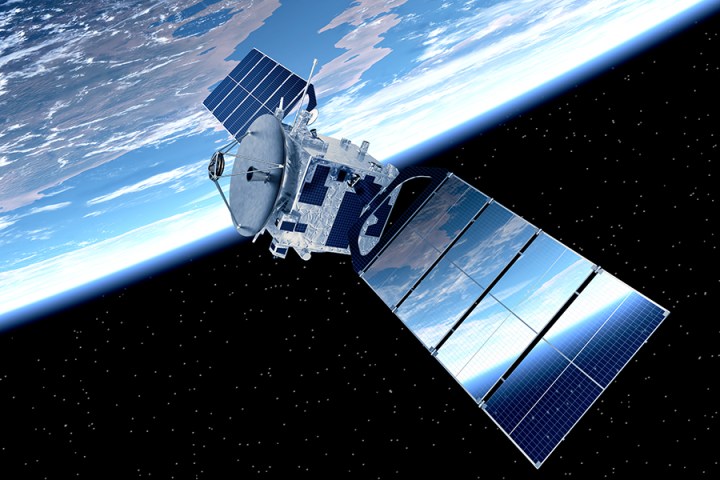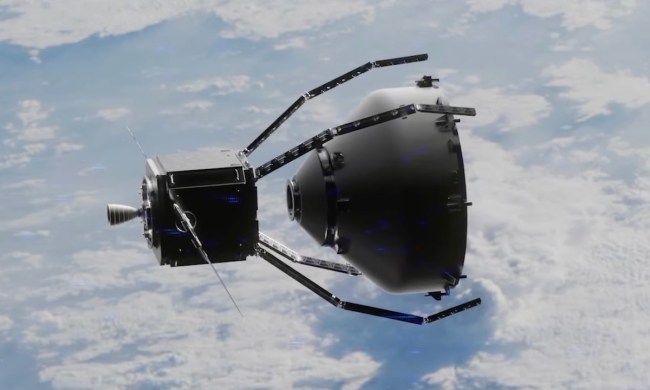In September of 2019, two satellites approximately 200 miles above the planet’s surface were zooming toward each other at a breakneck speed of 32,000 miles per hour. One was the European Space Agency’s (ESA) Aeolus Earth observation satellite and the other was one of SpaceX’s Starlink satellites, and with them both speeding toward the same region of space, scientists estimated a 1 in 1,000 probability that they would collide.
The US Air Force saw the two satellites heading for each other and warned both organizations, but due to what SpaceX described as a “bug” in its communications systems, it declined to take any action. If the satellites had crashed, both would have been utterly obliterated — and the impact would have thrown millions of small and large pieces of debris spinning off into space. Imagine the opening scene from the film Gravity, and now amplify that by an order of magnitude.
Fortunately for all of us, the ESA was able to maneuver its satellite to avoid the collision, and both satellites are now continuing safely in their orbits. This close call goes to show what can happen when space gets too full, however. When thousands or even millions of objects are flying around our planet at tremendous speeds, the potential for collisions is high.
We investigated what the consequences of all this space debris floating in space are, and got the inside scoop from Donald Kessler, formerly NASA’s Senior Scientist for Orbital Debris Research and one of the world’s leading experts on space debris.
The junk trap
When a satellite gets broken, generally no one goes up into space to fix it. When a rocket discards one of its stages, the stage is left to float wherever it is ejected. And when two objects in orbit impact each other, they can produce literally millions of small particles that go flying out into space and end up orbiting the Earth.
All of this discarded material is collectively known as space debris. It’s the junk that we’ve left in the space around our planet, and it’s growing every year.
In the late 1970s, when research on space debris was just beginning, Kessler proposed a scary possibility: that one day, there could be so much junk in low earth orbit that collisions would cascade until it was difficult or impossible to launch satellites without them being struck by debris. We’d essentially become prisoners on our own planet, and we’d have nobody but ourselves to blame.
Collisions have happened before and will likely happen again
If the worries about debris or about the SpaceX and ESA satellites potentially colliding sounded overblown to you, it’s worth noting that satellites have collided in the past, with terrible consequences.
In 2009, two satellites collided at an astonishing speed of 11,700 meters per second (26,000 miles per hour), not only destroying both objects but also smearing an enormous field of debris across their two orbits and beyond. One of the satellites was part of the Iridium constellation of communications satellites, and one was the deactivated Russian Space Force’s Kosmos satellite. The Kosmos satellite had been discarded and left in orbit at a time when few people took the threat of debris seriously.
This incident woke people up to the seriousness of the threat posed by debris. Not only could it destroy expensive satellites, but the collision made the problem much worse: NASA estimated that the event created 1,000 pieces of debris larger than 10 centimeters in size which could continue to threaten other satellites for thousands of years.
Debris threatens both the International Space Station and the Hubble Space Telescope

There are two major issues to consider when it comes to overcrowding in space. The first is how space debris can affect craft already in orbit around Earth, such as the International Space Station (ISS). The ISS sits in very low earth orbit, at a mean altitude of 330 kilometers (205 miles), which puts it bang in the middle of a whole lot of space debris. The ISS is particularly vulnerable to debris impacts because it is so large, so it had to be designed to withstand impacts from debris of up to 1 cm in size.
In order to handle the threat of other debris, the ISS watches for potential impacts and moves out of the way. “The space station was the first to start doing maneuvers in order to avoid anything that came close to it,” Kessler explained, “but the problem with those maneuvers is that you cannot predict that there’s going to be a collision. The tracking accuracy is only accurate enough to say that something is going to pass uncomfortably close to you, and that there is a probability of a collision. So they will do maneuvers under those circumstances.”
In the case of the ISS, it’s important to be extra careful because it is so large and because human lives are at stake. There are also all the other objects in low earth orbit to consider, like the Hubble Telescope which orbits at around 545 kilometers (340 miles) and other missions both manned and unmanned. And that’s not even mentioning all the satellites which sit at a higher geosynchronous orbit, where there is a debris problem as well.
Could debris become so bad it prevents satellite launches altogether?
The second issue to consider is how debris will effect future launches. In terms of traveling to distant planets, when you leave the Earth behind you travel through the debris field for such a short amount of time that it’s less likely to cause a problem. The problem arises when you look at objects which stay permanently within the debris fields, like satellites and manned or unmanned space missions.

“You can cross the street a lot safer than living in the middle of it,” Kessler explains.
Currently, the question is mostly thought about in terms of economics. Essentially, as debris worsens it will become more and more expensive to launch satellites. But what will happen beyond this is still an unknown due to a lack of research into this topic.
“No one has ever come up with an answer for ‘how bad an environment is too bad [for satellite launches to be possible]?’,” Kessler said. It’s vital for this question to be answered before we can be certain of at what point space debris will prevent us from launching objects into orbit entirely.
To fix the issue we need aggressive action now
If we’re going to fix this problem, we can’t just cross our fingers and hope for the best. To really address the issue of debris, Kessler says, “there does have to be more aggressive action.”

The most pressing issue is one of legislation. There are agreed-upon guidelines about the mitigation of debris, such as a guideline that anything launched into an orbit of below 2000 kilometers (1240 miles) needs to reenter the atmosphere to burn up within 25 years of its mission completion. This puts the responsibility for the removal of objects onto the company or agency which launches them.
But as it stands, these are guidelines and not laws. Kessler suggests we should make the guidelines about debris removal into rules, and impose penalties on organizations which don’t follow them. This would encourage people to follow them for everyone’s benefit.
However, even getting everyone to follow the current guidelines may not be enough. “There have been quite a few studies which have come to the same conclusion: Even if everybody followed the rules, it would be insufficient to stop the growth of debris,” Kessler said. That’s because collisions are still going on and creating ever more small debris pieces.
This is the reason we need step two: To remove the largest 500 pieces of debris from orbit. These are the big pieces that are relatively easy to track and that we know pose the most danger. And this is where new technology comes in.
New technologies could help us clean up our act
Kessler pointed to a paper by NASA researchers J.C. Liou and N.L. Johnson from 2006, which looked at what it would take to clear space debris. “If we started next year and removed five objects per year for the next 100 years,” Kessler said, “that would stabilize the orbital environment.”
However, retrieving large objects from orbit is extremely challenging. “These objects were not designed to be grabbed a hold of,” Kessler explained, “and many of them are spinning. Before you can grab the object, you have to stop the spinning. And some of these are as big as school buses.”

One suggestion of how to deal with this problem is to create a satellite servicing facility where satellites could be maintained and fixed to extend their lifespans, thereby creating a longer time period before they become junk. The same facility could even be used to bring objects down from orbit once they were no longer needed.
Other ideas of how to clear debris are also in the works, such as the RemoveDEBRIS satellite project which is testing methods for debris capture including nets, harpoons, and vision-based navigation. The European Space Agency is also investigating debris removal along with the Astroscale company by experimenting with adding a docking mechanism to satellites before launch to make them easier to catch one they are retired.
An international issue requiring international co-operation
Like the challenge of climate change, the problem of space debris is an international issue that is going to require international co-operation to address. If we want to keep using space for scientific research as well as for enabling technologies such as communications and GPS, we’re going to need to find a way to undo some of the damage we’ve already done — as well as finding new solutions for the future.
While we’re not likely to become stuck on Earth and totally lose our ability to travel to other planets any time soon, the existing debris field around the planet could directly impact our ability to study space. “What will hurt the most is not losing access to other planets, it’s losing the Hubble telescope,” Kessler said. “It could eventually become just a piece of debris. It’s our scientific curiosity that’s at risk.”



